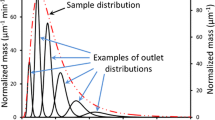Abstract
The development and applications of asymmetric flow field-flow fractionation (AF4) are outlined in comparison with the older and better-known size exclusion chromatography. Recent advances in AF4 instrumentation and predictions for further progress of the technique are given.
Similar content being viewed by others
Change history
04 June 2021
A Correction to this paper has been published: https://doi.org/10.1007/s10337-021-04054-7
References
Wahlund KG, Giddings JC (1987) Properties of an asymmetrical flow field-flow fractionation channel having one permeable wall. Anal Chem 59:1332–1339
Litzen A, Wahlund KG (1991) Zone broadening and dilution in rectangular and trapezoidal asymmetrical flow field-flow fractionation channels. Anal Chem 63:1001–1007
Joensson JA, Carlshaf A (1989) Flow field flow fractionation in hollow cylindrical fibers. Anal Chem 61:11–18
Johann C, Elsenberg S, Roesch U, Rambaldi DC, Zattoni A, Reschiglian P (2011) A novel approach to improve operation and performance in flow field-flow fractionation. J Chromatogr A 1218:4126–4131
Marassi V, Roda B, Casolari S, Ortelli S, Blosi M, Zattoni A, Costa AL, Reschiglian P (2018) Hollow-fiber flow field-flow fractionation and multi-angle light scattering as a new analytical solution for quality control in pharmaceutical nanotechnology. Microchem J 136:149–156
Berek D (2010) Size exclusion chromatography—a blessing and a curse of science and technology of synthetic polymers. J Sep Sci 33:315–335
Podzimek S (2012) Asymmetric flow field flow fractionation encyclopedia of analytical chemistry. John Wiley and Sons. https://doi.org/10.1002/9780470027318.a9289
Podzimek S (2011) Light scattering size exclusion chromatography and asymmetric flow field flow fractionation. John Wiley and Sons
Mudalige TK, Qu H, Sanches-Pomalez G, Sisco PN, Linder SW (2015) Simple functionalization strategies for enhancing nanoparticle separation and recovery with asymmetric flow field flow fractionation. Anal Chem 87:1764–1772
Gigault J, Pettibone JM, Schmitt C, Hackley VA (2014) Rational strategy for characterization of nanoscale particles by asymmetric-flow field flow fractionation: a tutorial. Anal Chim Acta 809:9–24
Otte T, Pasch H, Macko T, Bruell R, Stadler FJ, Kaschta J, Becker F, Buback M (2011) Characterization of branched ultrahigh molar mass polymers by asymmetrical flow field-flow fractionation and size exclusion chromatography. J Chrom A 1218:4257–4267
Makan AC, Williams RP, Pasch H (2016) Field flow fractionation for the size, molar mass, and gel content analysis of emulsion polymers for water-based coatings. Macromol Chem Phys 217:2027–2040
Beckett R, Bigelow JC, Jue Z, Giddings JC (1988) Analysis of humic substances using flow field-flow fractionation in aquatic humic substances. American Chemical Society. https://doi.org/10.1021/ba-1988-0219.ch005
Cho TJ, Hackley VA (2010) Fractionation and characterization of gold nanoparticles in aqueous solution: asymmetric-flow field flow fractionation with MALS, DLS, and UV–Vis detection. Anal Bioanal Chem 398:2003–2018
Alasonati E, Caebergs T, Petry J, Sebaihi N, Fisicaro P, Feltin N (2021) Size measurement of silica nanoparticles by asymmetric flow field-flow fractionation coupled to multi-angle light scattering: a comparison exercise between two metrological institutes. J Chromatogr A 1638:461859
Collins ME, Soto-Cantu E, Cueto R, Russo PS (2014) Separation and characterization of poly(tetrafluoroethylene) latex particles by asymmetric flow field flow fractionation with light-scattering detection. Langmuir 30:3373–3380
Fraunhofer W, Winter G (2004) The use of asymmetrical flow field-flow fractionation in pharmaceutics and biopharmaceutics. Eur J Pharm Biopharm 58:369–383
Evjen TJ, Hupfeld S, Barnert S, Fossheim S, Schubert R, Brandl M (2013) Physicochemical characterization of liposomes after ultrasound exposure—mechanisms of drug release. J Pharm Biomed Anal 78–79:118–122
Bousse T, Shore DA, Goldsmith CS, Hossain MJ, Jang Y, Davis CT, Donis RO, Stevens J (2013) Quantitation of influenza virus using field flow fractionation and multi-angle light scattering for quantifying influenza A particles. J Vir Met 193:589–596
Ehrhart J, Mingotaud AF, Violleau F (2011) Asymmetrical flow field-flow fractionation with multi-angle light scattering and quasi elastic light scattering for characterization of poly(ethyleneglycol-b-ɛ-caprolactone) block copolymer self-assemblies used as drug carriers for photodynamic therapy. J Chrom A 1218:4249–4256
Zhang H, Lyden D (2019) Asymmetric-flow field-flow fractionation technology for exomere and small extracellular vesicle separation and characterization. Nat Protoc 14:1027–1053
Caputo F, Clogston J, Calzolai L, Roesslein M, Prina-Mello A (2019) Measuring particle size distribution of nanoparticle enabled medicinal products, the joint view of EUNCL and NCI-NCL. A step by step approach combining orthogonal measurements with increasing complexity. J Control Release 299:31–43
Caputo F, Mehn D, Clogston JD, Rösslein M, Prina-Mello A, Borgos SE, Gioria S, Calzolai L (2021) Asymmetric-flow field-flow fractionation for measuring particle size, drug loading and (in)stability of nanopharmaceuticals. J Chrom A. https://doi.org/10.1016/j.chroma.2020.461767
Hu Y, Crist RM, Clogston JD (2020) The utility of asymmetric flow field-flow fractionation for preclinical characterization of nanomedicines. Anal Bioanal Chem 412:425–438
Johann C, Elsenberg S, Schuch H, Roesch U (2015) Instrument and method to determine the electrophoretic mobility of nanoparticles and proteins by combining electrical and flow field-flow fractionation. Anal Chem 87:4292–4298
Funding
This is not a supported research.
Author information
Authors and Affiliations
Contributions
SP prepared the first draft of the manuscript and focused mainly on the applications in polymer area and comparing SEC with AF4. CJ expanded the text mainly in the area of pharmaceuticals and nanoparticle research. Both authors have given approval to the final version of the manuscript.
Corresponding author
Ethics declarations
Conflict of interest
There is no conflict of interest from the side of authors.
Additional information
Publisher's Note
Springer Nature remains neutral with regard to jurisdictional claims in published maps and institutional affiliations.
Rights and permissions
About this article
Cite this article
Podzimek, S., Johann, C. Asymmetric Flow Field-Flow Fractionation: Current Status, Possibilities, Analytical Limitations and Future Trends. Chromatographia 84, 531–534 (2021). https://doi.org/10.1007/s10337-021-04035-w
Received:
Revised:
Accepted:
Published:
Issue Date:
DOI: https://doi.org/10.1007/s10337-021-04035-w




